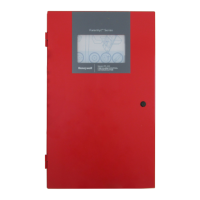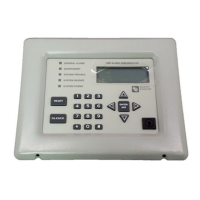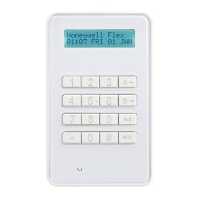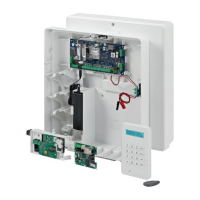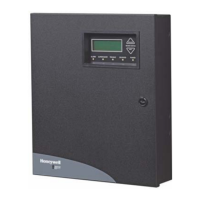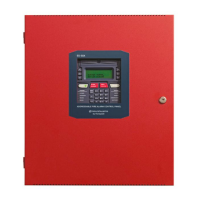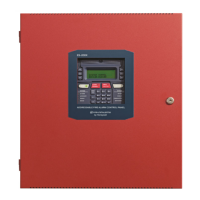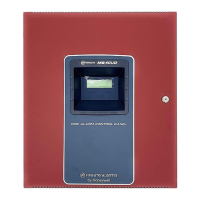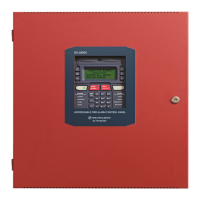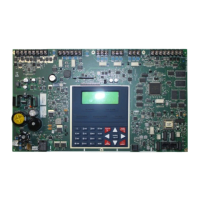IFP-75 Series Manual — P/N LS10147-001SK-E:E 4/6/2022 33
Wiring Specifications Control Panel Installation
4.6.2 Calculating Wiring Distance for SBUS Modules
The following instructions will guide you in determining the type of wire and the maximum wiring distance that can be used with SBUS
accessory modules.
To calculate the wire gauge that must be used to connect SBUS modules to the panel, it is necessary to calculate the total worst case current
draw for all modules on a single 4-conductor bus. The total worst case current draw is calculated by adding the individual worst case currents
for each module. The individual worst case values are shown in the table below.
After calculating the total worst case current draw, Table 4.8 specifies the maximum distance the modules can be located from the panel on a
single wire run. The table ensures 6.0 volts of line drop maximum. In general, the wire length is limited by resistance, but for heavier wire
gauges, capacitance is the limiting factor.
These cases are marked in the chart with an asterisk (*). Maximum length can never be more than 6,000 feet, regardless of gauge used. (The
formula used to generate this chart is shown in the chart below).
The following formulas were used to generate the wire distance chart.
NOTE: Total worst case current draw on a single SBUS cannot exceed 1 amp. If a large number of accessory modules are required and the
worst case current draw will exceed the 1 amp limit, then the current draw must be distributed using RPS-1000 Power Expanders. Each RPS-
1000 Power Expander provides an additional SBUS, with an additional 1 amp of SBUS current. Wiring distance calculations are done separately
for each RPS-1000, and separately for the panel itself.
Model Number Worst Case Current Draw
RA-2000, RA-1000, RA-100 Fire Annunciators 0.120 amps
5824 Serial/Parallel Printer Interface Module 0.045 amps
5880 LED I/O Module 0.250 amps
5865 LED Annunciator 0.200 amps
RPS-1000 Intelligent Power Supply 0.010 amps
5496 NAC Expander 0.010 amps
SK-NIC Network Interface Card 0.021 amps
CELL-MOD/CELL-CAB-SK 0.145 amps
SK-F485C Fiber Converter 0.125 amps
Table 4.7 SBUS Device Current Draw
Wiring Distance: SBUS Modules to Panel
Total Worst Case
Current Draw (amps)
22 Gauge 18 Gauge 16 Gauge 14 Gauge
0.100 1852 ft. 4688 ft. * 6000 ft. * 6000 ft.
0.200 926 ft. 2344 ft. 3731 ft. 5906 ft.
0.300 617 ft. 1563 ft. 2488 ft. 3937 ft.
0.400 463 ft. 1172 ft. 1866 ft. 2953 ft.
0.500 370 ft. 938 ft. 1493 ft. 2362 ft.
0.600 309 ft. 781 ft. 1244 ft. 1969 ft.
0.700 265 ft. 670 ft. 1066 ft. 1687 ft.
0.800 231 ft. 586 ft. 933 ft. 1476 ft.
0.900 206 ft. 521 ft. 829 ft. 1312 ft.
1.000 (Max) 185 ft. 469 ft. 746 ft. 1181 ft.
Table 4.8 Wire Distances Per Wire Gauge
Maximum Resistance (Ohms) = 6.0 Volts
Total Worst Case Current Draw (amps)
Maximum Wire Length (Feet) =
(6000 feet maximum)
Maximum Resistance (Ohms) * 500
Rpu
where: Rpu = Ohms per 1000 feet for various Wire Gauges (see table below)
Wire Gauge Ohms per 1000 feet (Rpu)
22 16.2
18 6.4
Table 4.9 Typical Wire Resistance Per 1,000 ft.

